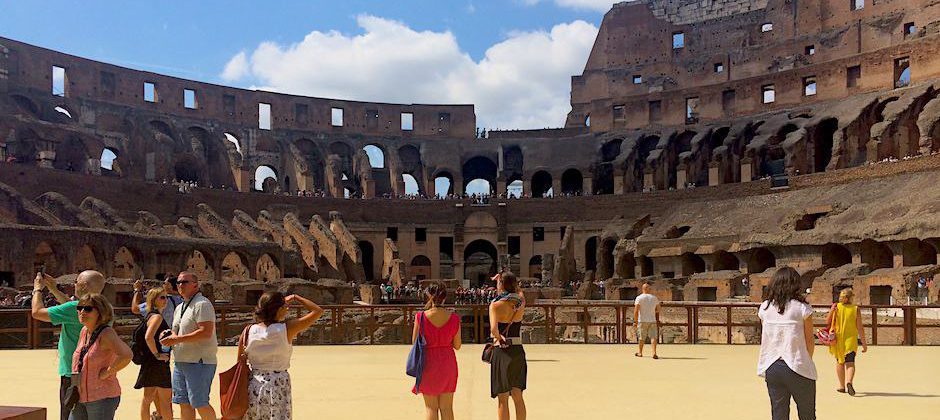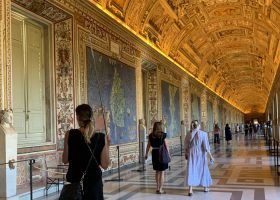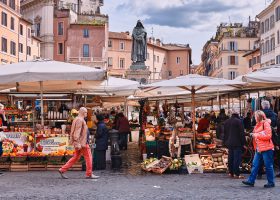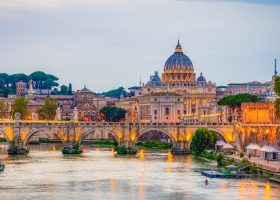Heading to the Colosseum, Palatine Hill, and Roman Forum and not sure what to see or where to start? It’s a lot to take in, we know. Follow our suggested itinerary of the top things to see at the Colosseum.
Pro Tip: Planning can be tough, but it’s easier to organize your trip when you have all your resources in one place. Create a browser folder and bookmark this post along with our dedicated guide to planning your visit to Rome, where you’ll find everything you need. Check out our article on the best Colosseum tours. Also, take a look at the top things to see at Palatine Hill and Roman Forum.
Outside the Colosseum
12. The Base of the Colossal Statue of Nero
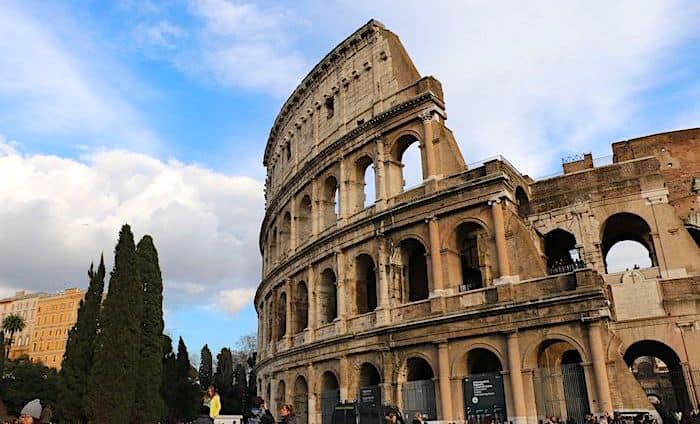
Right across from the Colosseum metro station and in front of the Colosseum itself is the base of the Colossal Statue of Nero. It isn’t much to look at today, but an important element to pass by on your way in. You’ll see a plaque reading “Area Del Basamento del Colosseo di Nerone.”
The Colossal Statue of Nero was a massive structure that measured, including the base, 106.5 Roman feet, according to Pliny the Elder. That would be about 99 feet (30.3 meters) in today’s measurements. It was built in the likeness of Nero, at least his face, until after his death when it was modified to the likeness of the sun god Sol.
You have to imagine that this statue was almost the size of the Statue of Liberty, only 10 or so feet shorter. Built and constructed without any of the machinery used to construct our Lady Liberty in the late industrial revolution.
A great example is that the statue was moved after Nero’s death to right outside the Colosseum, and ancient writers said it took some 40 elephants to transport the structure. The last mention of it in history was in the late fourth century before it vanished into thin air. Today, all we have is a portion of the base with trees growing out of it. A great place to take a load off and enjoy the shade.
Address: Piazza del Colosseo, 1
11. The Arch of Constantine
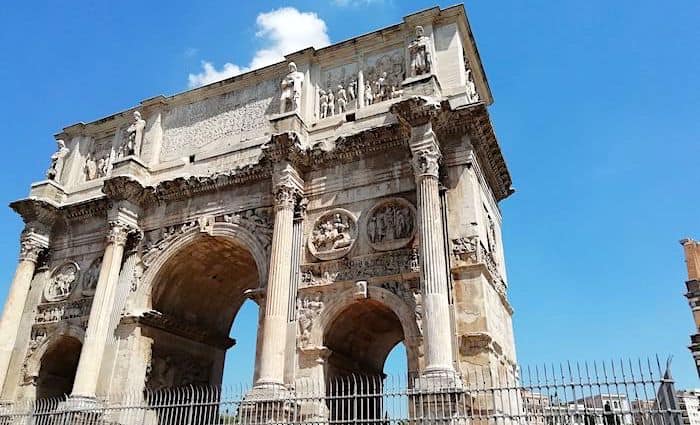
Flavius Valerius Constantinus, or Constantine the Great to most of us, was the first Christian Emperor of Rome. A triumphant arch was built and dedicated to him for his victory over Maxentius at the Battle of Milvian Bridge in A.D. 312. It’s an epic arch right in front of the Colosseum.
It sits in the Piazza del Colosseo, adjacent to the massive amphitheater, and took about two years to construct—which is record speed! The architect took some creative liberties by borrowing from some of the statues of nearby arches, temples, and structures to adorn Constantine’s arch.
It is the largest Roman arch and one of only three remaining arches in Rome. There were 36 triumphant arches by the fourth century A.D., just three of which have survived.
Address: Via di San Gregorio
10. The Outer Ring
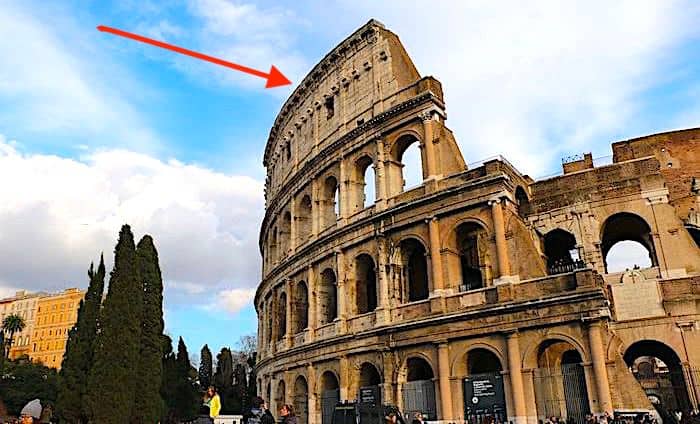
The first thing you’ll notice when you get closer to the Colosseum is that it has multiple rings to support seating. The remaining portion of the outer ring will be facing you as you walk out of the metro station and definitely puts this building into perspective. Three sets of arches stand on top of one another to form the 159-foot tall outer ring.
Upon Completion
When they completed the Colosseum, this ring circled the entire structure, but after a thousand years without repairs or attention it fell down in an earthquake in 1349. There were 80 archways that made up the outer ring and each of them had a number. Spectators were assigned an archway number to guide them to their seats.
It was an extremely efficient process that allowed the building to completely fill up and empty within 15 minutes or so. There were 76 numbered entrances for public use. The remaining four gates were for different uses and didn’t have numbers.
There were two entrances for gladiators to come in and out: The Libitinarian Gate, between numbers 57 and 58, which was for dead gladiators. Between numbers 19 and 20 was where gladiators would enter the structure, sometimes called the Gate of Life. Roman Magistrates entered between gates 38 and 39, which can still be seen today. The Emperor, Vestal Virgins, and Senators would enter between gates 76 and 1—this gate is now the exit of the Colosseum.
Address: Piazza del Colosseo, 1
9. Flavian Amphitheater Plaque
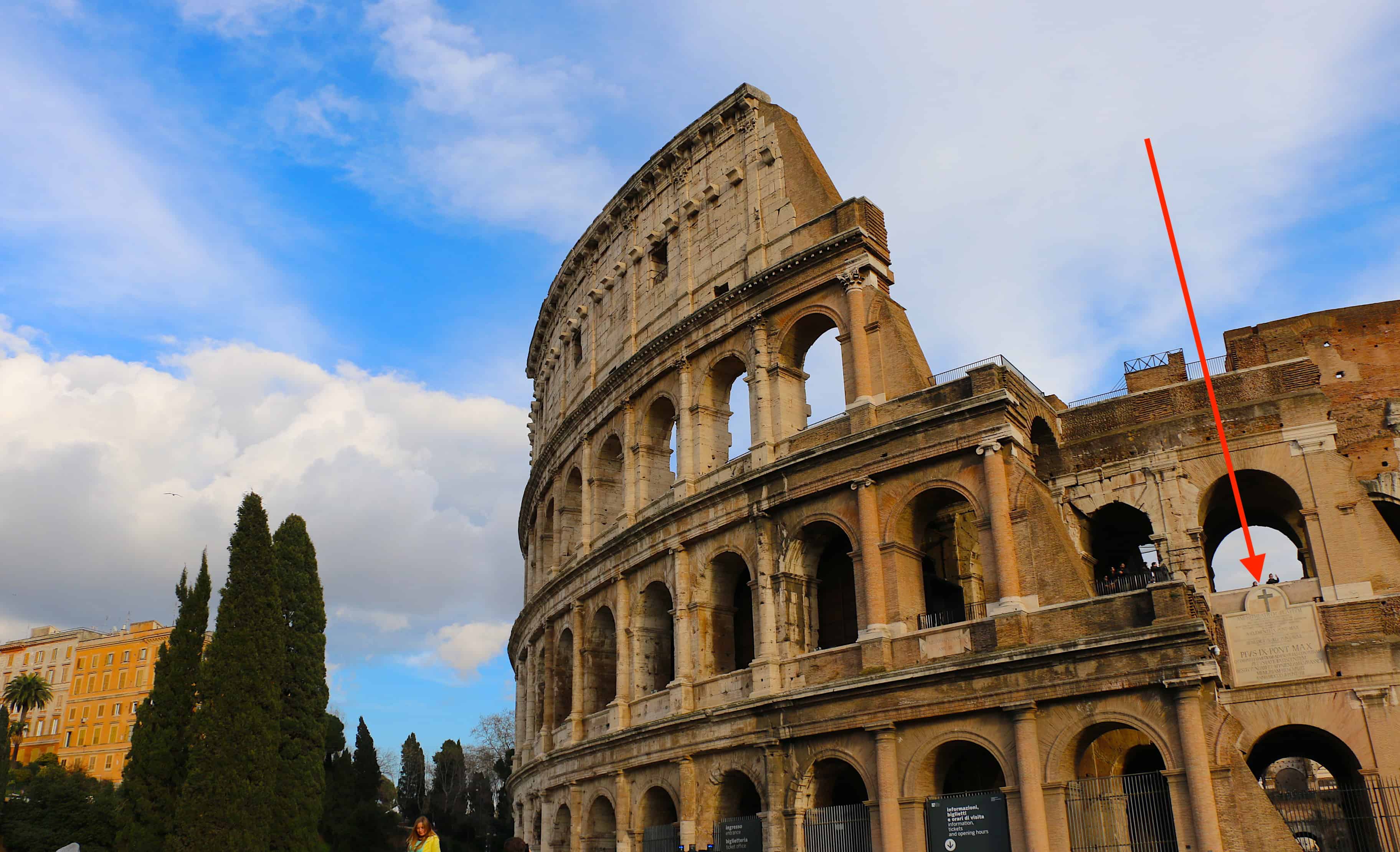
The Colosseum is, in fact, only a nickname for the structure. The real name of the building is the Flavian Amphitheatre, named after the dynasty that built it. See the plaque attached to the middle ring of the Colosseum directly facing the Temple of Venus.
The plaque has the name of the structure, Amphitheater Flavium, and the names of a few popes who were essential in preserving the building.
Address: Piazza del Colosseo, 1
8. Ludus Magnus
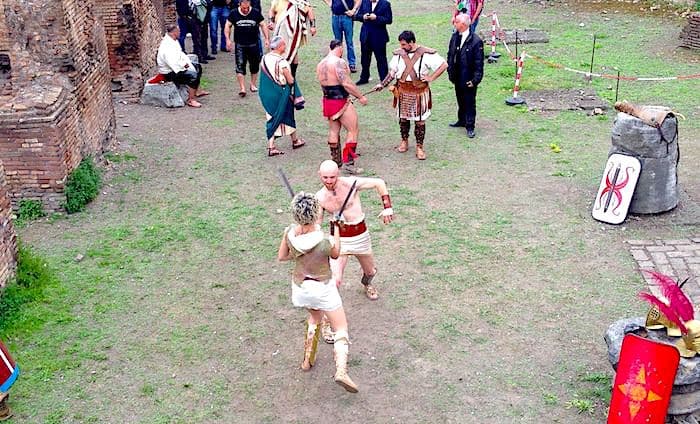
Just across from the Colosseum on Via di San Giovanni in Laterano are the remains of the Ludus Magnus—the closest and greatest gladiator training school in the empire. It has many cells for slaves and even an underground tunnel directly connected to the Colosseum.
The Ludus was built by Emperor Domitian. Just after the Colosseum was finished in A.D. 82 (with a soft opening in A.D. 80), they must have realized there were some supply chain issues with great fighters, so Domitian decided to take it upon himself to rectify the situation.
The school underwent renovations and improvements, but it was more or less used for over 200 years. Gladiators came from across the empire to train, as free persons or slaves, in what was the Harvard of gladiator schools—the Ludus Magnus.
The word ludi could be used to refer to the games and training all the same. Once you entered a ludus, your primary skillset would be chosen and you’d be trained by a lanista. The word gladiator was one specific type of fighter that fought with a short sword known as the gladius. This was popularized by the movie “Gladiator” starring Russel Crow, which is possibly the best movie ever produced.
Address: Via di S. Giovanni in Laterano
Inside the Colosseum
7. The Cross
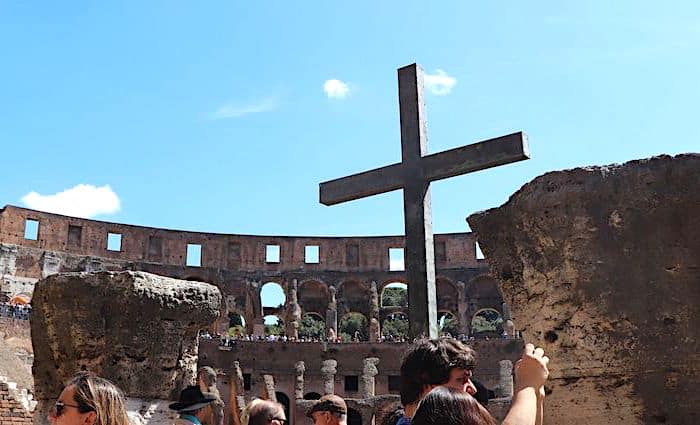
In the year 2000, the Colosseum placed a cross in memory of all the Christian martyrs that the Romans killed inside the Colosseum. While it is almost definite that Christians died inside the Colosseum, it is dubious whether or not they died because they were Christian. The Romans didn’t really care about the Christians or persecute them heavily.
Address: Piazza del Colosseo, 1
6. The Gate of Death
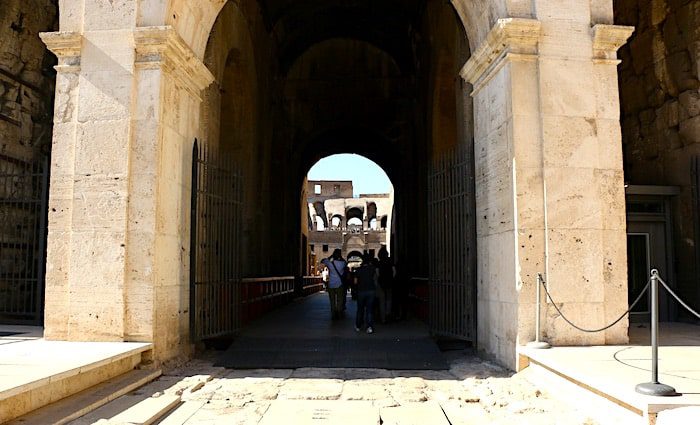
No visit to the Colosseum is complete without walking through the Gate of Death—or more formally, the Libitinarian Gate. As mentioned above, this was where the dead, beat-up, and bloody exited the Colosseum. The word stems from libitinarius which translates to “undertaker” in Latin.
This is another exclusive area, so be sure to check out one of our Colosseum restricted access tours. If the description says it includes the Arena Floor, you’ll get to walk through this legendary gate! Now you understand why this is one of the top things to see at the Colosseum.
Please note: No tours currently include the Gate of Death, which is temporarily closed. We’ll update this as soon as it reopens.
Address: Piazza del Colosseo, 1
5. The Arena Floor (Special Access)
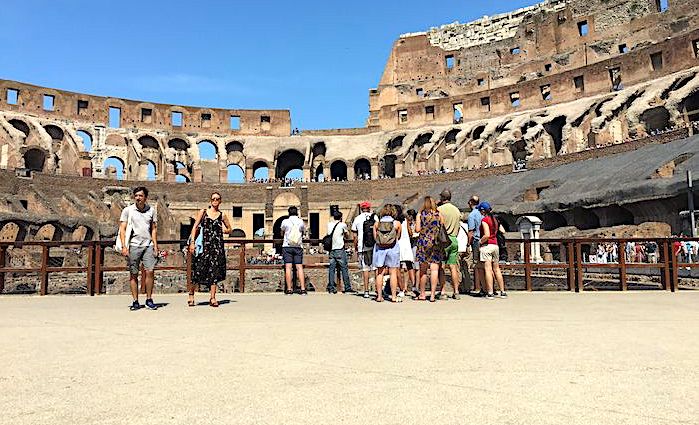
The word arena means sand, and the Colosseum is apparently where the use of the word derives. They’d say “down on the arena,” which referred to the sand that covered the stage. Now, we use the word when referring to stadiums as a whole, like the basketball arena.
A framework of tunnels supported the arena floor of the Colosseum, whose stone walls supported the wooden floor. There were as many as 36 trap doors through which all kinds of hellish things were unleashed on the person standing on the stage.
Today, we have zoos and online images that make it easy to recognize almost any animal. In the first century AD, they could only recognize an animal that they’d seen in person. Often, it would have been the first time they had ever seen these exotic animals, which were starved, beaten, and unleashed on a trained fighter. This is, in my opinion, one of the top things to see at the Colosseum.
You cannot access this area with general admission, but we have a guided tour that takes you onto the arena floor!
Address: Piazza del Colosseo, 1
4. The Underground (Hypogeum)
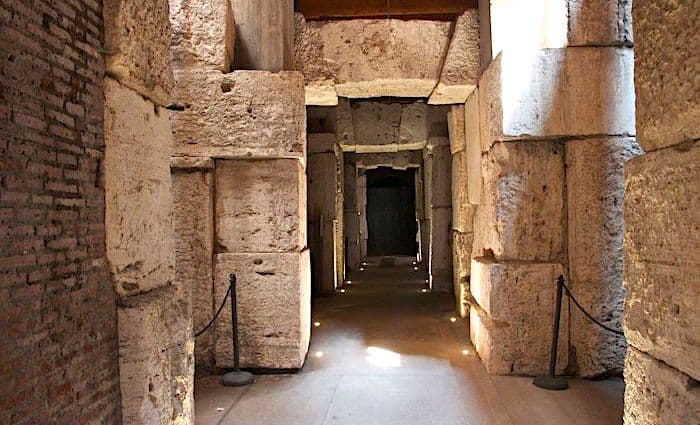
Underneath the Colosseum, there’s a complex labyrinth of tunnels once used by gladiators and event organizers. This is by far the most popular subject that visitors want to hear about and that was before they even opened the area for tours.
It’s really one of the defining features of the Colosseum. What other stadium or arena has trap doors that allow fighters or animals to elevate or pop out of? The underground or hypogeum was a very complex area. It had as many as 36 trap doors and areas to store an entire show’s worth of entertainment.
Without a doubt, it’s the most exclusive area of the Colosseum. General admission won’t get you there, but we have a Colosseum Underground tour that takes you there. Plan ahead—tickets are super limited and hard to come by.
Address: Piazza del Colosseo, 1
3. Food Vendor Artifacts (Second Floor)
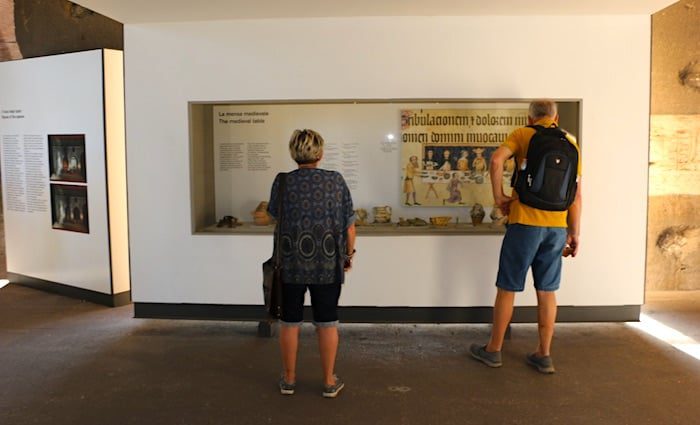
Find the elevator inside the Colosseum on the second floor. There, you’ll find some very cool artefacts once used inside the building, including cups and spoons.
Many find it surprising that ancient people were so advanced, but this is a part of human culture. You have to feed the crowds! And it was probably a great way to make money if you were a vendor.
We can speculate as to what they ate or we can trust ancient Roman writers. In archeological digs, things like oyster shells or nut shells have been found near the site. Typically, Romans ate a lot of fruit like plums, figs, grapes, pears, almonds, and of course chestnuts.
Romans often drank different types of alcoholic beverages, mostly derived from grapes in a form of wine. Calda was a popular winter drink—a warm watered-down wine with spices very similar to mulled wine. Posca was a vinegar-type beverage that peasants drank. Patricians drank regular wine mixed with water.
You could most likely also find any type of meat at stands, including chicken, lamb, boar or various fish like catfish from the Tiber River.
Address: Piazza del Colosseo, 1
2. Second Floor Balcony
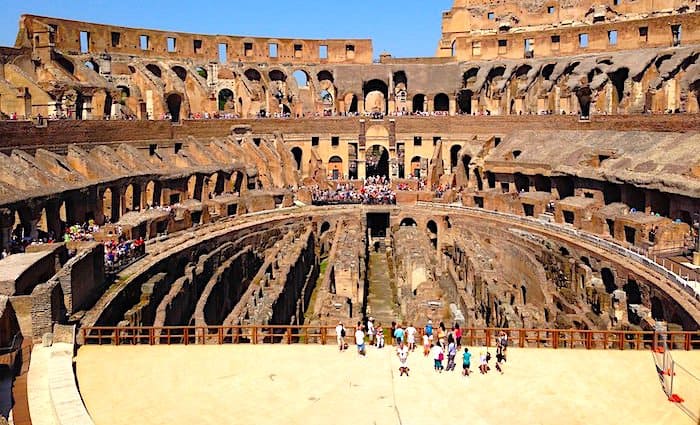
Once out of the concession stand area, look down at the center of the Colosseum and head in a clock-wise direction. When you get to the apex of the ellipse, you’ll find an awesome balcony where you can snap a picture. Look down to your right and you’ll see a reconstruction of some of the original seats of the Colosseum.
The levels of the Colosseum were organized by class and social standing, which was an entitlement by birth. The Emperor sat in the first tier obviously and he had his own podium, much like in “Gladiator”. On the same level sat the vestal virgins, senators, and magistrates.
The equites or knights sat in the second tier. They were of a similar social class as senators, but military in nature. These were the people who sat around the second-floor balcony where you find yourself now.
Address: Piazza del Colosseo, 1
Popular Tours from Rome
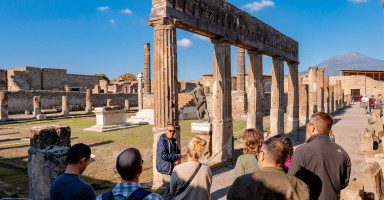
Best Seller
Unforgettable Rome Day Trip to Pompeii and Sorrento
Making a day trip from Rome to Pompeii and the Amalfi Coast can be daunting, with long travel times, complex routes, and tricky logistics to manage. Our full-day tour eliminates the stress, offering comfortbale transport straight to Pompeii. With an archaeologist guide, explore the ancient ruins without the hassle. Then, unwind with free time in Sorrento’s coastal charm. Led by a local guide and small group, this trip makes experiencing Italy’s highlights easy and enjoyable—all in one day.
See prices and more info
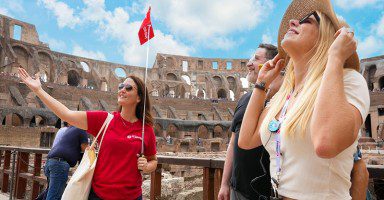
Best Seller
Rome in a Day Tour with Colosseum & Vatican Museums
Seeing the best of Rome in a single day might seem like a big undertaking, but our expertly designed tour makes it effortless with skip-the-line tickets, included transportation, and engaging guides to lead the way. In just 7 hours, you’ll visit renowned sites like the Sistine Chapel, Colosseum, Trevi Fountain, and Pantheon. With fascinating stories at every stop, you can skip the stress and immerse yourself in the vibrant heritage and culture of Rome all in one remarkable day.
See prices and more info
1. The Third, Fourth, and Fifth Floors (currently closed)
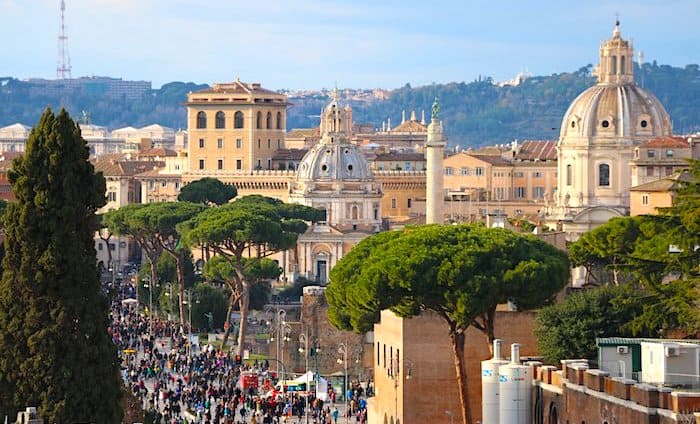
Plebians populated the third and largest tier. This class included commoners without noble bloodlines, who could also be wealthy so they separated these seats into two tiers. The lower, better seats for the wealthy plebeians and the upper seats for the true commoners.
They made the fourth and final tier of wooden rows, while all other tiers were marble. It was in this area where the common woman sat.
They often close these areas today, but if they are open during your visit, try to secure access to the top tiers of the Colosseum. You’ll find yourself at a much higher altitude than expected. We have a tour that covers the area. If you see departure times that means it is open. It also includes the Underground and Arena Floor.
Address: Piazza del Colosseo, 1
Top Colosseum Tours
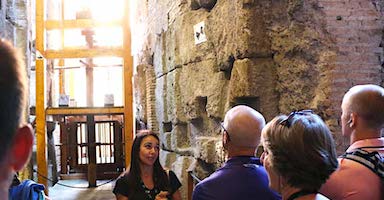
Best Seller
Colosseum Underground Tour with Roman Forum and Palatine Hill
Only 2% of visitors to the Colosseum are able to see the Underground, making tours a rare, exclusive experience. Our tours give you access to the Underground, Arena Floor, and first and second tiers—areas most people never see. Skip the line and enjoy priority access, guided by an expert who brings the Colosseum’s rich history to life. These spots sell out quickly, so don’t wait—secure your place now for this unforgettable opportunity.
See Prices
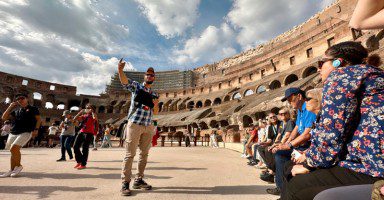
Customer Favorite
Special Access Colosseum Arena Floor Tour Through the Gladiator’s Gate
Reaching the Colosseum’s Arena Floor is no easy feat; tickets sell out quickly, leaving most visitors stuck in crowded corridors with limited views. With us, bypass the lines and enter through the Gladiator’s Gate to stand on the Arena Floor, giving you a front-row view of Rome’s nearly 2,000-year-old symbol of power and glory. With your friendly guide, uncover the Colosseum’s brutal past, then continue to the Roman Forum and Palatine Hill to explore the epicenter of ancient Roman life.
See Prices
Not ready to book a tour? Check out more info on the Colosseum.
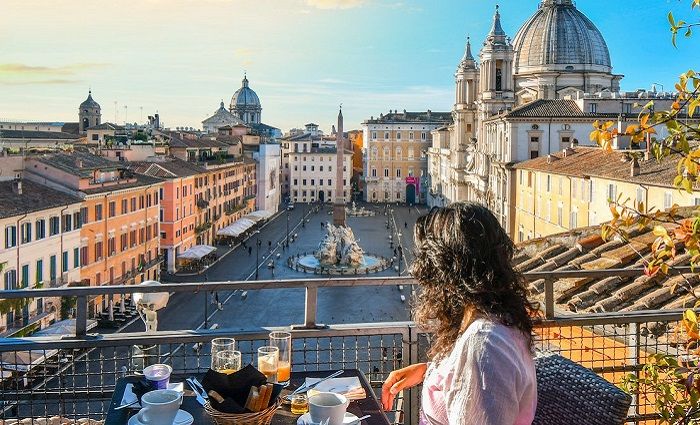
Where To Stay in Rome
Rome has a rich cultural history and many iconic landmarks to explore. Plan where to stay in the magnificent Eternal City in the best neighborhoods.

